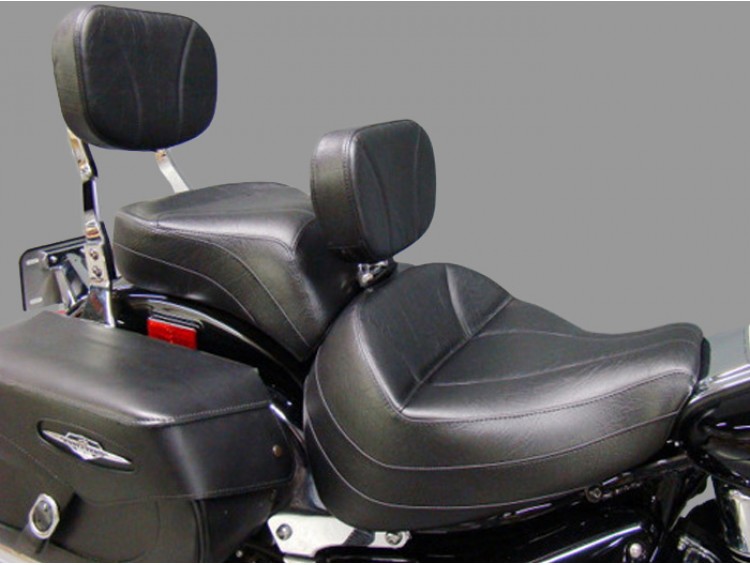



Shopping Basket
| Items: | 0 |
| Subtotal: | $0.00 |
Specializing in
Ultimate Motorcycle Seats.
Have Questions?
Email us at
or call us at: 334-488-4119

Motorcycle Seat and Riding Tips - Top 10 Ways to Improve Riding Comfort
Do you experience pain or numbness in your neck, back, arms, hands or legs while riding? Would you like to ride your motorcycle without pain or fatigue? Are you passionate about riding your motorcycle but you have had neck/back surgery and aren’t sure if you should ride? Here are a few simple things to consider and changes you can make that will improve your riding comfort and bring the fun back into your riding experience.
1. Back Position
If your back begins to hurt during your ride, it could be because your back is out of sync with your arm and leg positions as you sit in your motorcycle seat. The human body was designed to operate best when all of your parts are in line with one another. Your motorcycle seat should promote this. Chiropractors perform adjustments on folks who have performed tasks without keeping their body in line with itself. Your spinal column can be out of line, causing pain, discomfort, and numbness in your legs. If you experience any of these symptoms apart from during motorcycle riding, your body is out of line. Consult a doctor and possibly see a chiropractor for help.
If you only experience these symptoms during motorcycle riding, it stands to reason that you are riding your bike in a position that is putting your body out of line with itself. The three positions (back, arm and leg) are going to be determined somewhat by which style of bike you ride and your motorcycle seat style. Of course, your sport bikes are going to be geared for more athletically fit riders, or at least for riders who are well accustomed to this position of riding. With either sport or touring style bikes, simple changes can eliminate back pain and fatigue. These changes include raising or lowering your motorcycle seat (if this is possible on your bike), changing the type of motorcycle seat you are using, moving your handlebars closer or further from your body and motorcycle seat, or moving your foot rests to match your back position. Try to keep in mind that you want your body to be in line with itself as much as possible. Make your bike comfortable for you. Do you feel like you have to reach too far for your handlebars during normal riding? This will affect your lower back, for sure. Try adjusting your handlebars closer to your body and motorcycle seat. Of course, every bike is different, so you will have to look into your bike’s specific adjustment capabilities. Try adjusting your foot pegs/rests to a more comfortable position in relation to your motorcycle seat.
2. Backrests
Many riders say that adding a backrest to their rider seat has provided the back support that was missing, and thus improved their riding comfort, eliminating lower back fatigue. Backrests can be added to your stock motorcycle seat, but they can be added to your aftermarket motorcycle seat.
3. Neck Position
Of course neck position will be determined by several things. Windshield height and motorcycle seat position play a part in neck position. Just keep in mind that you want to keep your body in line with itself as much as possible. You want to keep your neck in a straight line with you back and shoulders for maximum comfort. You want to be able to look straight ahead without moving your head out of line with your back. Consider adjusting/changing your windshield height to help with this. Of course, sport bike riders will have more of a challenge with this, as they are leaning forward and must look up with their heads to see straight ahead. Even so, adjustments in motorcycle seat position or changing your motorcycle seat can help with this.
4. Arm Position
We’ve talked about arm position in relation to your body, that you can make some adjustments in handlebar position to make your riding more comfortable. Rise, width and pullback are three primary measurements of handlebars, and some adjustments can be made here. You can also consider changing handlebar styles. The best way to know is to actually try riding bikes with different types of handlebars. And, the type of motorcycle seat you use will determine your distance to your handlebars. A motorcycle seat can move you closer to or further from your handlebars. Choose an aftermarket motorcycle seat to help you with this.
Arm position also includes arm height. Many riders say that ape bars that place their arms just below shoulder height have greatly improved their comfort in riding.
5. Leg Position
The ideal leg position is one that puts your legs at a right angle to your spine. Having your leg position too low puts strain on your knees, hips, feet and back. You can adjust your foot pegs or floor boards forward and up to add stretch and comfort. Ideally, you want your weight to be supported by your seat and not your feet. Your feet should only offer balance. They should not be supporting your body weight during riding. If you have highway pegs, adjust them to your comfort. Highway pegs are excellent at offering a leg stretch and an optional foot position for those long rides. And for flat footed confidence in stopping, consider lowering your suspension, both front and rear. This will also immediately lower your motorcycle seat height while adding a slammin’ look to your bike!
6. Windshields
Naturally, many riders prefer to ride without windshields. But if you are having neck or back problems, you might consider adding a windshield. This will drastically reduce the wind that hits your neck and head, and you will notice less pain and fatigue in your neck and back, especially on long rides.
7. Helmet Style
Believe it or not, the weight of your helmet can be a factor in neck and back comfort. It’s possible that your helmet could be too heavy! Try a lighter weight helmet to see if this helps your neck and back.
8. Vibration Solutions
Vibration in motorcycle riding can be caused by many different things. Obviously, the type of bike you have is a factor. If it’s supposed to vibrate, it’s gonna vibrate. But if you have a bike that’s not supposed to vibrate, maybe you need a tune up. In addition to above, have both wheels statically and dynamically balanced. This reduces wobble, increases road holding ability, reduces tire wear and reduces rider fatigue. You should check forks and swing arm for correct operation. Vibration can occur when there is a lack of fork oil and too much side play in the swing arm. Check the pannier box lids for proper fit and that they are locked. Check for worn neck bearings, for a bad motor mount, for tire pressure and tread, and for wheel weight problems. All of these factors contribute to motorcycle seat vibration problems, Also, hand fatigue caused by vibration in the handlebars can be remedied by changing to better handlebar grips.
9. Motorcycle Seat Style and Materials
Are you riding on your stock motorcycle seat? It’s possible that your stock motorcycle seat does not have enough cushion, and this will greatly affect your ride. Vibration absorption can be greatly improved by changing to a more comfortable aftermarket motorcycle seat, many of which are made with gel cushions. You can also buy gel pads to place on top of your stock motorcycle seat that will improve comfort. And an aftermarket motorcycle seat will add style as well as comfort to your bike.
A low-rider motorcycle seat is suitable for riders up to 200 lbs., up to 6 feet tall, or with an inseam of up to 33 inches. A mid-rider motorcycle seat is best for riders between 200 and 240 lbs, are over 6 feet tall, or have a 34” inseam. A big-boy motorcycle seat goes well with riders who are over 260 lbs, over 6 feet tall or who have more than a 34” inseam. Having the right motorcycle seat for your body makes all the difference.
10. Exercise – Before and After Riding
Think of it like this: Muscles need to be stretched and warmed up before performing any athletic activity. Likewise, after any exercise program, cool-down is important. Motorcycle riding is no different. You are going to be sitting in your motorcycle seat in basically one position for a length of time. It only makes sense that stretching before and after riding would add to your riding comfort and relieve tension after riding. Even stretching during gas stops will help.
Simple neck rolls, arm-behind-head stretches, ham-string stretches, shoulder circles or any other basic warm-up/cool-down stretches and exercises will cut down on tension that occurs during riding. Finally, try to remember to ride in a relaxed position with head, neck, back, shoulders, arms, hips, legs and feet all in line with each other. Everything works together, and these principles work in everything you do, not just in motorcycle riding.
Bonus
And finally, most chiropractors and doctors will tell you, that if you’ve had back surgery of any kind, motorcycle riding is out. This will depend on the severity of your back/neck surgery or surgeries, but for the most part, many riders have eased back into riding gradually, as their necks and backs have regained strength. Modifications to your bike can certainly help. Be cautious, but don’t give up. If your passion is to ride, then take steps to begin riding. Testimonies of neck/back surgery patients who have ridden their bikes again are numerous. You can find many of these testimonies in motorcycle forums. Once a biker, always a biker!
Consider each of these suggestions and implement as many as you can, and you are sure to improve the quality of your ride. After all, who wants to suffer when there is so much of life to be enjoyed from the back of a bike!
Comfort for the Journey!

GOD BLESS OUR TROOPS
AND ALL WHO GAVE THEIR ALL
IN THE LINE OF DUTY
Great Savings!
All month long!
Up to $75 off!
If your purchase is:
$500 - save $20!
$900 - save $40!
$1200- save $60!
$1400 or more -
save $75!
Best time to buy is
NOW!
(Savings given at checkout)
Sale ends
12/31/25
Thank you for choosing
NBMotorcycleSeats.com!
We appreciate your business!




